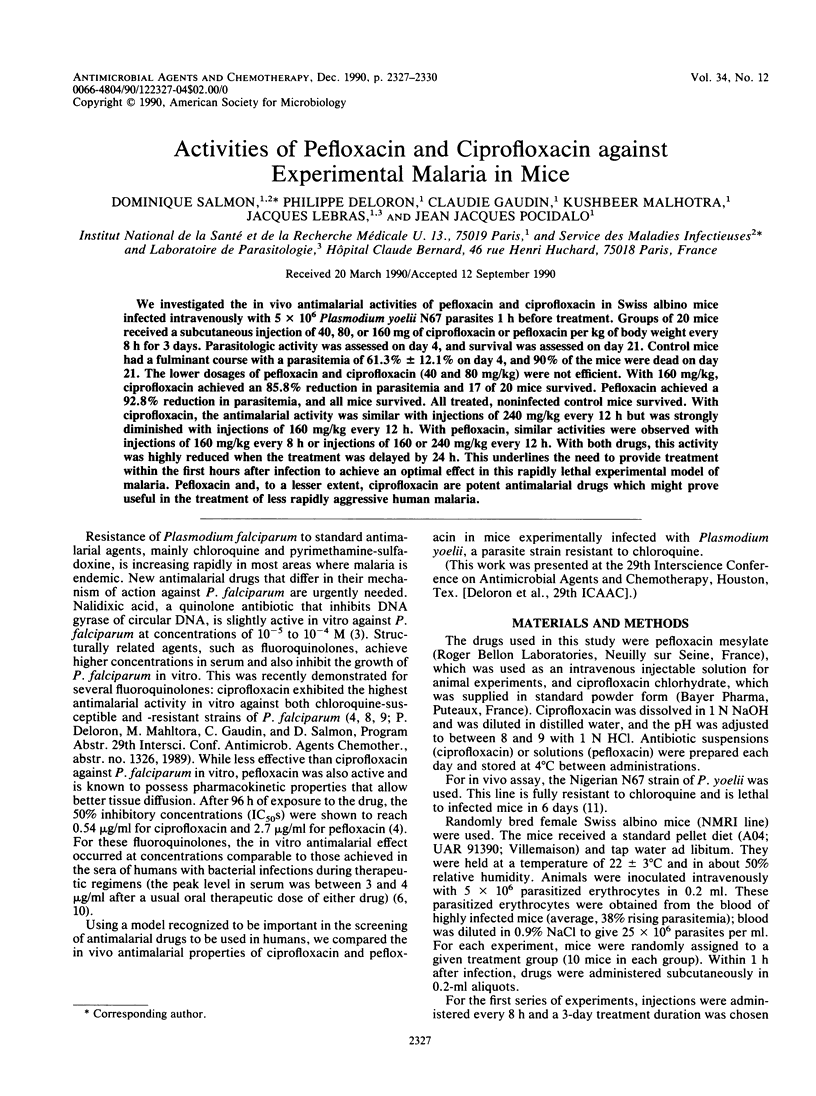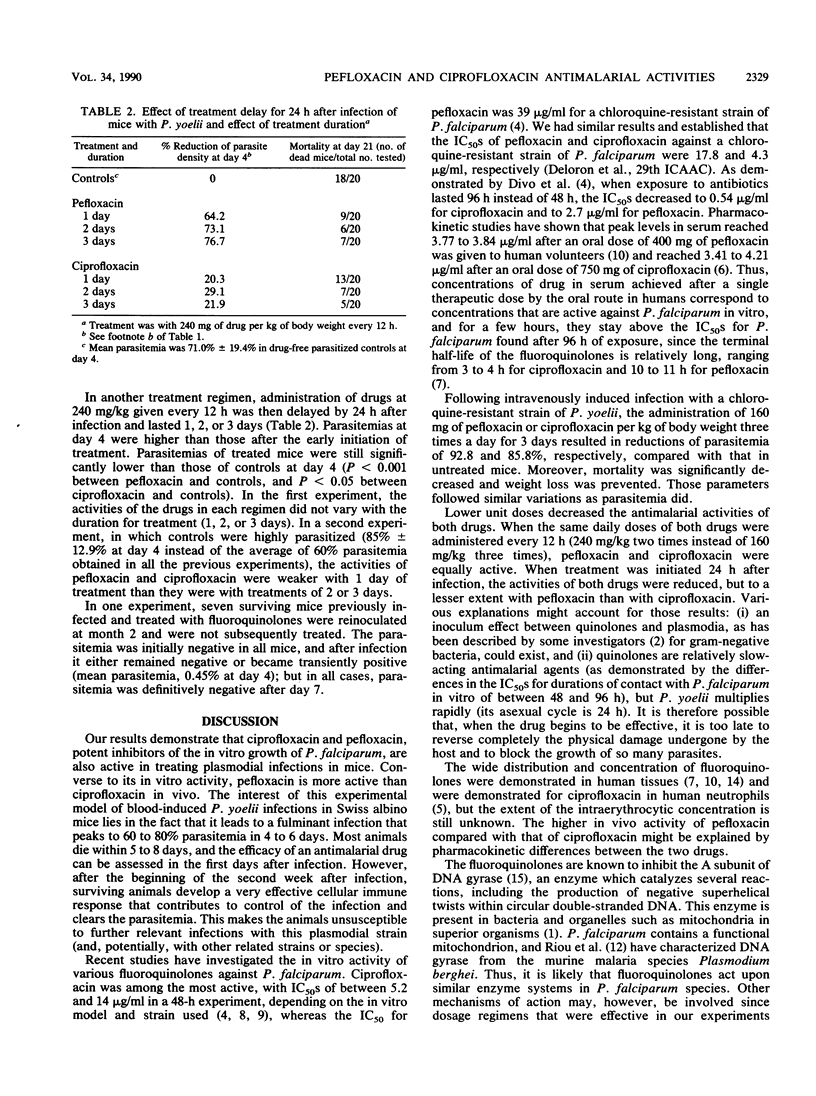Abstract
We investigated the in vivo antimalarial activities of pefloxacin and ciprofloxacin in Swiss albino mice infected intravenously with 5 x 10(6) Plasmodium yoelii N67 parasites 1 h before treatment. Groups of 20 mice received a subcutaneous injection of 40, 80, or 160 mg of ciprofloxacin or pefloxacin per kg of body weight every 8 h for 3 days. Parasitologic activity was assessed on day 4, and survival was assessed on day 21. Control mice had a fulminant course with a parasitemia of 61.3% +/- 12.1% on day 4, and 90% of the mice were dead on day 21. The lower dosages of pefloxacin and ciprofloxacin (40 and 80 mg/kg) were not efficient. With 160 mg/kg, ciprofloxacin achieved an 85.8% reduction in parasitemia and 17 of 20 mice survived. Pefloxacin achieved a 92.8% reduction in parasitemia, and all mice survived. All treated, noninfected control mice survived. With ciprofloxacin, the antimalarial activity was similar with injections of 240 mg/kg every 12 h but was strongly diminished with injections of 160 mg/kg every 12 h. With pefloxacin, similar activities were observed with injections of 160 mg/kg every 8 h or injections of 160 or 240 mg/kg every 12 h. With both drugs, this activity was highly reduced when the treatment was delayed by 24 h. This underlines the need to provide treatment within the first hours after infection to achieve an optimal effect in this rapidly lethal experimental model of malaria. Pefloxacin and, to a lesser extent, ciprofloxacin are potent antimalarial drugs which might prove useful in the treatment of less rapidly aggressive human malaria.
Full text
PDF



Selected References
These references are in PubMed. This may not be the complete list of references from this article.
- Castora F. J., Vissering F. F., Simpson M. V. The effect of bacterial DNA gyrase inhibitors on DNA synthesis in mammalian mitochondria. Biochim Biophys Acta. 1983 Sep 9;740(4):417–427. doi: 10.1016/0167-4781(83)90090-8. [DOI] [PubMed] [Google Scholar]
- Davey P. G., Barza M. The inoculum effect with gram-negative bacteria in vitro and in vivo. J Antimicrob Chemother. 1987 Nov;20(5):639–644. doi: 10.1093/jac/20.5.639. [DOI] [PubMed] [Google Scholar]
- Divo A. A., Geary T. G., Jensen J. B. Oxygen- and time-dependent effects of antibiotics and selected mitochondrial inhibitors on Plasmodium falciparum in culture. Antimicrob Agents Chemother. 1985 Jan;27(1):21–27. doi: 10.1128/aac.27.1.21. [DOI] [PMC free article] [PubMed] [Google Scholar]
- Divo A. A., Sartorelli A. C., Patton C. L., Bia F. J. Activity of fluoroquinolone antibiotics against Plasmodium falciparum in vitro. Antimicrob Agents Chemother. 1988 Aug;32(8):1182–1186. doi: 10.1128/aac.32.8.1182. [DOI] [PMC free article] [PubMed] [Google Scholar]
- Easmon C. S., Crane J. P. Uptake of ciprofloxacin by human neutrophils. J Antimicrob Chemother. 1985 Jul;16(1):67–73. doi: 10.1093/jac/16.1.67. [DOI] [PubMed] [Google Scholar]
- Gonzalez M. A., Moranchel A. H., Duran S., Pichardo A., Magana J. L., Painter B., Forrest A., Drusano G. L. Multiple-dose pharmacokinetics of ciprofloxacin administered intravenously to normal volunteers. Antimicrob Agents Chemother. 1985 Aug;28(2):235–239. doi: 10.1128/aac.28.2.235. [DOI] [PMC free article] [PubMed] [Google Scholar]
- Hooper D. C., Wolfson J. S. The fluoroquinolones: pharmacology, clinical uses, and toxicities in humans. Antimicrob Agents Chemother. 1985 Nov;28(5):716–721. doi: 10.1128/aac.28.5.716. [DOI] [PMC free article] [PubMed] [Google Scholar]
- Krishna S., Davis T. M., Chan P. C., Wells R. A., Robson K. J. Ciprofloxacin and malaria. Lancet. 1988 May 28;1(8596):1231–1232. doi: 10.1016/s0140-6736(88)92056-9. [DOI] [PubMed] [Google Scholar]
- Midgley J. M., Keter D. W., Phillipson J. D., Grant S., Warhurst D. C. Quinolones and multiresistant Plasmodium falciparum. Lancet. 1988 Jul 30;2(8605):281–281. doi: 10.1016/s0140-6736(88)92571-8. [DOI] [PubMed] [Google Scholar]
- Montay G., Goueffon Y., Roquet F. Absorption, distribution, metabolic fate, and elimination of pefloxacin mesylate in mice, rats, dogs, monkeys, and humans. Antimicrob Agents Chemother. 1984 Apr;25(4):463–472. doi: 10.1128/aac.25.4.463. [DOI] [PMC free article] [PubMed] [Google Scholar]
- Peters W., Davies E. E., Robinson B. L. The chemotherapy of rodent malaria, XXIII Causal prophylaxis, part II: Practical experience with Plasmodium yoelii nigeriensis in drug screening. Ann Trop Med Parasitol. 1975 Sep;69(3):311–328. [PubMed] [Google Scholar]
- Riou J. F., Gabillot M., Philippe M., Schrevel J., Riou G. Purification and characterization of Plasmodium berghei DNA topoisomerases I and II: drug action, inhibition of decatenation and relaxation, and stimulation of DNA cleavage. Biochemistry. 1986 Apr 8;25(7):1471–1479. doi: 10.1021/bi00355a001. [DOI] [PubMed] [Google Scholar]
- Sarma P. S. Norfloxacin: a new drug in the treatment of falciparum malaria. Ann Intern Med. 1989 Aug 15;111(4):336–337. doi: 10.7326/0003-4819-111-4-336. [DOI] [PubMed] [Google Scholar]
- Wise R., Lockley R. M., Webberly M., Dent J. Pharmacokinetics of intravenously administered ciprofloxacin. Antimicrob Agents Chemother. 1984 Aug;26(2):208–210. doi: 10.1128/aac.26.2.208. [DOI] [PMC free article] [PubMed] [Google Scholar]
- Wolfson J. S., Hooper D. C. The fluoroquinolones: structures, mechanisms of action and resistance, and spectra of activity in vitro. Antimicrob Agents Chemother. 1985 Oct;28(4):581–586. doi: 10.1128/aac.28.4.581. [DOI] [PMC free article] [PubMed] [Google Scholar]


